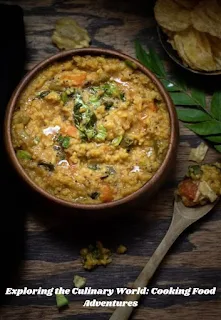Onset:
Amidst
the rich tapestry of South Indian cuisine, there exists a dish that stands as
the ultimate comfort food – Sambar Rice, affectionately known
as Sambar Sadam. Embark on a culinary journey that unveils the
vibrant medley of flavors and textures in this beloved dish. In this
composition, we will delve into the art of crafting the perfect Sambar
Rice, inviting you to explore a world where hearty taste and nourishing
virtue intertwine.
The
Essence of Sambar Rice:
Ingredients:
- 1 cup of short-grain rice, perfectly
cooked
- 1 cup of toor dal (split
pigeon pea lentils), boiled and mashed
- 2 cups of mixed vegetables (such
as carrots, beans, peas), diced
- 1 medium-sized onion,
finely diced
- 1 medium-sized tomato,
finely diced
- 2 tbsp of tamarind extract,
diluted in water
- 1 tsp of sambar powder
- 1 tbsp of turmeric powder
- A pinch of asafoetida (hing)
- 1 tbsp of mustard seeds
- 1 tbsp of cumin seeds
- 2-3 dried red chilies,
broken
- A handful of curry leaves
- Ghee or
cooking oil, for tempering
- Fresh coriander leaves,
for garnish
Instructions:
- Begin by cooking the rice and toor
dal until they are soft and well-cooked. Mash the dal and set it
aside.
- In a large pot, heat a teaspoon
of ghee or cooking oil.
- Add the mustard seeds and
let them splutter, then add the cumin seeds, dried red
chilies, and a pinch of asafoetida. Sauté for a moment.
- Incorporate the finely diced onion and
sauté until it turns translucent.
- Introduce the minced tomatoes and
cook until they soften and blend into the mixture.
- Add the diced vegetables, sambar
powder, turmeric powder, and salt. Sauté for a
few minutes to allow the flavors to meld.
- Pour in the diluted tamarind
extract and bring the mixture to a gentle boil. Allow the
vegetables to cook until tender.
- Once the vegetables are cooked, add
the mashed toor dal and mix well. Adjust the consistency
with water if needed.
- Simmer the mixture for a few more
minutes to let the flavors fully infuse.
- In a separate tempering pan, heat a
little ghee or cooking oil. Add a handful of curry
leaves and let them crackle. Pour this tempering over the
prepared Sambar Rice, giving it a delightful finishing touch.
- Garnish with fresh coriander
leaves for a burst of color and freshness.
Savoring
the Sambar Rice Symphony:
Indulging
in a plate of Sambar Rice is akin to experiencing a symphony
of flavors that celebrate the essence of South Indian culinary tradition. The
harmonious blend of tender rice, delicate toor dal, and an array
of vegetables creates a melodic fusion of textures and tastes.
The sweet dance of aromas and the tangy notes of tamarind elevate
this dish to a culinary masterpiece that warms the heart and satisfies the
soul. Each spoonful of Sambar Rice encapsulates the essence of
comfort and nourishing sustenance.
Healthy
Highlights:
Beyond
its delectable taste, Sambar Rice offers nutritional
advantages that contribute to a well-rounded diet. The diverse assortment
of vegetables provides an array of vitamins, minerals, and
dietary fiber. The protein-rich toor dal adds a substantial
element, while the judicious use of spices offers inherent health
benefits. Sambar Rice strikes a perfect equilibrium between
indulgence and nutrition, making it a favorite among health-conscious
individuals and food enthusiasts alike.
Parting
Palate Pleasure:
Sambar
Rice,
or Sambar Sadam, epitomizes the joyous fusion of flavor and
tradition in South Indian cuisine. This comforting dish, with its interplay of
textures, flavors, and nutrients, has carved a special place in the hearts and
kitchens of many. Prepare a serving of Sambar Rice, relish the
symphony of South Indian flavors, and immerse yourself in a culinary experience
that transcends boundaries, resonating with a universal love for succulent,
hearty food.










0 Comments
Thank you for your comment! I appreciate your feedback. If you are passionate about food, do not miss our latest blog post below. Read it and enjoy the flavourful journey!